The Maximum Subarray Problem
Download as PPTX, PDF3 likes3,596 views
The document discusses the maximum subarray problem and different solutions to solve it. It defines the problem as finding a contiguous subsequence within a given array that has the largest sum. It presents a brute force solution with O(n2) time complexity and a more efficient divide and conquer solution with O(nlogn) time complexity. The divide and conquer approach recursively finds maximum subarrays in the left and right halves of the array and the maximum crossing subarray to return the overall maximum.
1 of 8
Downloaded 76 times

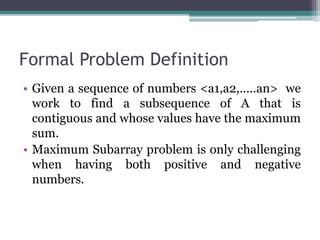
![ĘĪ│µ▓╣│Š▒Ķ▒¶▒ŌĆ”
Here, the subarray A[8ŌĆ”11] is the Maximum
Subarray, with sum 43, has the greatest sum of
any contiguous subarray of array A.](https://image.slidesharecdn.com/d2216e5c-75da-44c5-ab56-829b21931b58-150413003852-conversion-gate01/85/The-Maximum-Subarray-Problem-3-320.jpg)

![Divide and Conquer Solution
ŌĆó First we Divide the array A [low ŌĆ” high] into two
subarrays A [low ŌĆ” mid] (left) and A [mid +1 ŌĆ”
high] (right).
ŌĆó We recursively find the maximum subarray of A
[low ŌĆ” mid] (left), and the maximum of A [mid
+1 ŌĆ” high] (right).
ŌĆó We also find maximum crossing subarray that
crosses the midpoint.
ŌĆó Finally we take a subarray with the largest sum
out of three.](https://image.slidesharecdn.com/d2216e5c-75da-44c5-ab56-829b21931b58-150413003852-conversion-gate01/85/The-Maximum-Subarray-Problem-5-320.jpg)
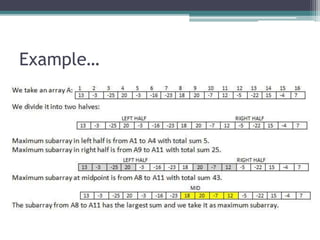
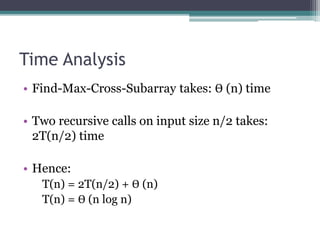
![Pseudo Code
Max-subarray(A, Left, Right)
if (Right == Left)
return (left, right, A[left])
else mid= [(left+right)/2]
L1=Find-Maximum-Subarray(A,left,mid)
R1=Find-Maximum-Subarray(A,mid+1,right)
M1=Find-Max-Crossing-Subarray(A,left,mid,right)
If sum(L1) > sum(R1) and sum(L1) > sum(M1)
Return L1
elseif sum(R1) > sum(L1) and sum(R1) > sum(M1)
Return R1
Else return M1](https://image.slidesharecdn.com/d2216e5c-75da-44c5-ab56-829b21931b58-150413003852-conversion-gate01/85/The-Maximum-Subarray-Problem-8-320.jpg)
Recommended
Branch and bound



Branch and boundDr Shashikant Athawale
╠²
The branch-and-bound method is used to solve optimization problems by traversing a state space tree. It computes a bound at each node to determine if the node is promising. Better approaches traverse nodes breadth-first and choose the most promising node using a bounding heuristic. The traveling salesperson problem is solved using branch-and-bound by finding an initial tour, defining a bounding heuristic as the actual cost plus minimum remaining cost, and expanding promising nodes in best-first order until finding the minimal tour.BackTracking Algorithm: Technique and Examples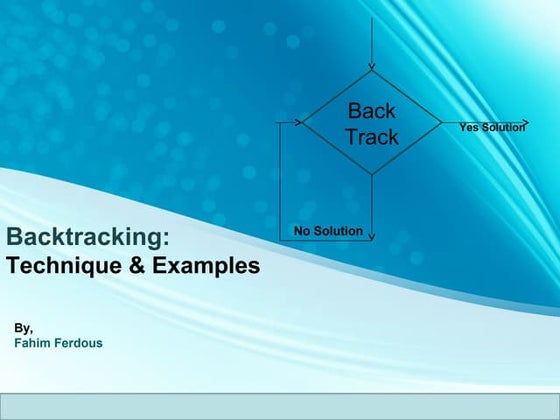



BackTracking Algorithm: Technique and ExamplesFahim Ferdous
╠²
This slides gives a strong overview of backtracking algorithm. How it came and general approaches of the techniques. Also some well-known problem and solution of backtracking algorithm.Greedy Algorithm - Knapsack Problem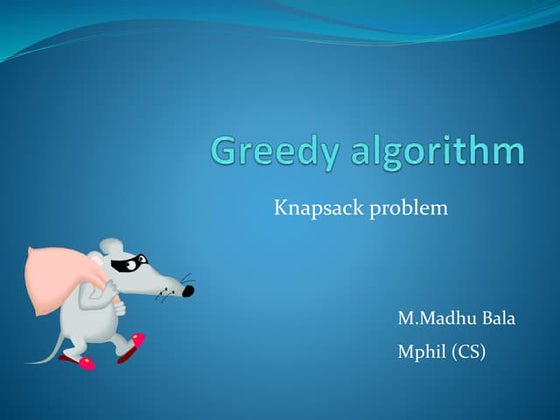



Greedy Algorithm - Knapsack ProblemMadhu Bala
╠²
The document discusses the knapsack problem and greedy algorithms. It defines the knapsack problem as an optimization problem where given constraints and an objective function, the goal is to find the feasible solution that maximizes or minimizes the objective. It describes the knapsack problem has having two versions: 0-1 where items are indivisible, and fractional where items can be divided. The fractional knapsack problem can be solved using a greedy approach by sorting items by value to weight ratio and filling the knapsack accordingly until full.Backtracking



Backtrackingsubhradeep mitra
╠²
This document discusses various problems that can be solved using backtracking, including graph coloring, the Hamiltonian cycle problem, the subset sum problem, the n-queen problem, and map coloring. It provides examples of how backtracking works by constructing partial solutions and evaluating them to find valid solutions or determine dead ends. Key terms like state-space trees and promising vs non-promising states are introduced. Specific examples are given for problems like placing 4 queens on a chessboard and coloring a map of Australia.Merge sort algorithm



Merge sort algorithmsrutisenpatra
╠²
This power point presentation will give you the knowledge of merge sort algorithm how it works with a given problem solving example. It also describe about the time complexity of merge sort algorithm, and the program in c . All pair shortest path



All pair shortest pathArafat Hossan
╠²
The document discusses the all pairs shortest path problem, which aims to find the shortest distance between every pair of vertices in a graph. It explains that the algorithm works by calculating the minimum cost to traverse between nodes using intermediate nodes, according to the equation A_k(i,j)=min{A_{k-1}(i,j), A_{k-1}(i,k), A_{k-1}(k,j)}. An example is provided to illustrate calculating the shortest path between nodes over multiple iterations of the algorithm.Greedy algorithms



Greedy algorithmsRajendran
╠²
This document discusses greedy algorithms and dynamic programming techniques for solving optimization problems. It covers the activity selection problem, which can be solved greedily by always selecting the shortest remaining activity. It also discusses the knapsack problem and how the fractional version can be solved greedily while the 0-1 version requires dynamic programming due to its optimal substructure but non-greedy nature. Dynamic programming builds up solutions by combining optimal solutions to overlapping subproblems.sum of subset problem using Backtracking



sum of subset problem using BacktrackingAbhishek Singh
╠²
Given a set of non-negative integers, and a value sum, determine if there is a subset of the given set with sum equal to given sum.Algorithms Lecture 1: Introduction to Algorithms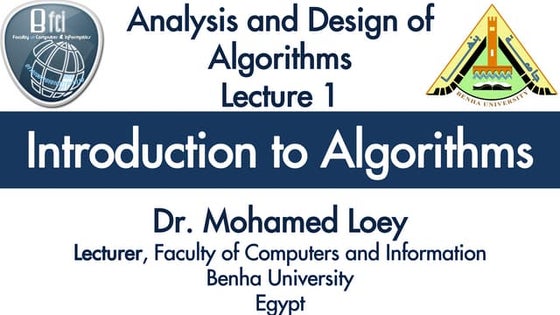



Algorithms Lecture 1: Introduction to AlgorithmsMohamed Loey
╠²
We will discuss the following: Algorithms, Time Complexity & Space Complexity, Algorithm vs Pseudo code, Some Algorithm Types, Programming Languages, Python, Anaconda.Dynamic programming



Dynamic programmingY─▒ld─▒r─▒m Tam
╠²
A. Plannig
The document mentions that in dynamic programming, "Programming" refers to "planning", not computer programming.0/1 knapsack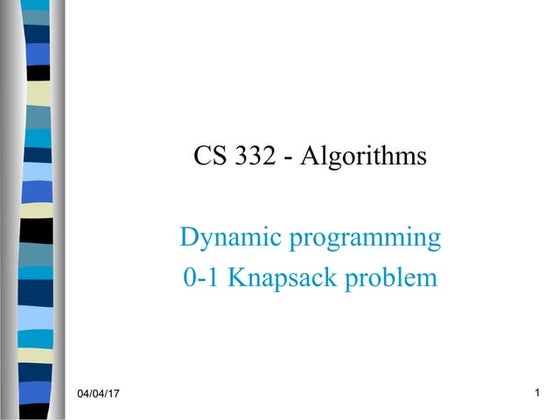



0/1 knapsackAmin Omi
╠²
The document discusses the 0-1 knapsack problem and how it can be solved using dynamic programming. It first defines the 0-1 knapsack problem and provides an example. It then explains how a brute force solution would work in exponential time. Next, it describes how to define the problem as subproblems and derive a recursive formula to solve the subproblems in a bottom-up manner using dynamic programming. This builds up the solutions in a table and solves the problem in polynomial time. Finally, it walks through an example applying the dynamic programming algorithm to a sample problem instance.Bruteforce algorithm



Bruteforce algorithmRezwan Siam
╠²
This powerpoint slide is for educational purposes only.!
We have given our best to educate people about the basic brute-force algorithm. Best of luck.Fractional Knapsack Problem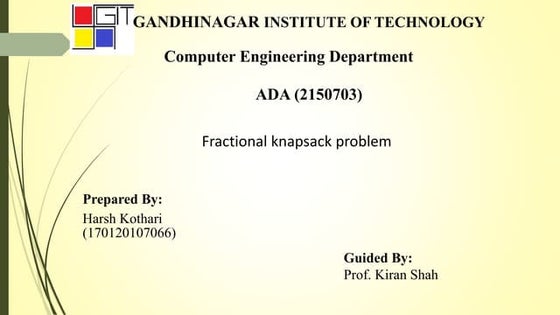



Fractional Knapsack Problemharsh kothari
╠²
This document discusses the greedy algorithm approach and the knapsack problem. It defines greedy algorithms as choosing locally optimal solutions at each step in hopes of reaching a global optimum. The knapsack problem is described as packing items into a knapsack to maximize total value without exceeding weight capacity. An optimal knapsack algorithm is presented that sorts by value-to-weight ratio and fills highest ratios first. An example applies this to maximize profit of 440 by selecting full quantities of items B and A, and half of item C for a knapsack with capacity of 60.Strassen's matrix multiplication



Strassen's matrix multiplicationMegha V
╠²
The document discusses Strassen's algorithm for matrix multiplication. It begins by explaining traditional matrix multiplication that has a time complexity of O(n3). It then explains how the divide and conquer strategy can be applied by dividing the matrices into smaller square sub-matrices. Strassen improved upon this by reducing the number of multiplications from 8 to 7 terms, obtaining a time complexity of O(n2.81). His key insight was applying different equations on the sub-matrix multiplication formulas to minimize operations.Quick sort Algorithm Discussion And Analysis



Quick sort Algorithm Discussion And AnalysisSNJ Chaudhary
╠²
Quicksort is a divide-and-conquer algorithm that works by partitioning an array around a pivot element and recursively sorting the subarrays. In the average case, it has an efficiency of ╬ś(n log n) time as the partitioning typically divides the array into balanced subproblems. However, in the worst case of an already sorted array, it can be ╬ś(n^2) time due to highly unbalanced partitioning. Randomizing the choice of pivot helps avoid worst-case scenarios and achieve average-case efficiency in practice, making quicksort very efficient and commonly used.Hashing Technique In Data Structures



Hashing Technique In Data StructuresSHAKOOR AB
╠²
This document discusses different searching methods like sequential, binary, and hashing. It defines searching as finding an element within a list. Sequential search searches lists sequentially until the element is found or the end is reached, with efficiency of O(n) in worst case. Binary search works on sorted arrays by eliminating half of remaining elements at each step, with efficiency of O(log n). Hashing maps keys to table positions using a hash function, allowing searches, inserts and deletes in O(1) time on average. Good hash functions uniformly distribute keys and generate different hashes for similar keys.Greedy algorithms



Greedy algorithmssandeep54552
╠²
Greedy algorithms work by making locally optimal choices at each step to arrive at a global optimal solution. They require that the problem exhibits the greedy choice property and optimal substructure. Examples that can be solved with greedy algorithms include fractional knapsack problem, minimum spanning tree, and activity selection. The fractional knapsack problem is solved greedily by sorting items by value/weight ratio and filling the knapsack completely. The 0/1 knapsack problem differs in that items are indivisible.Matrix chain multiplication



Matrix chain multiplicationRespa Peter
╠²
Dynamic Programming is a technique for algorithm design.
It is a tabular method in which it uses divide-and-conquer to solve problems.Assignment problem branch and bound.pptx



Assignment problem branch and bound.pptxKrishnaVardhan50
╠²
1. Branch and bound is an algorithm that uses a state space tree to solve optimization problems like the knapsack problem and traveling salesman problem. It works by recursively dividing the solution space and minimizing costs at each step.
2. The document then provides an example of using branch and bound to solve a job assignment problem with 4 jobs and 4 people. It calculates lower bounds at each step of the algorithm and prunes branches that cannot lead to an optimal solution.
3. After exploring the solution space, the algorithm arrives at the optimal assignment of Person A to Job 2, Person B to Job 1, Person C to Job 3, and Person D to Job 4, with a minimum total cost of 21.Stressen's matrix multiplication



Stressen's matrix multiplicationKumar
╠²
Strassen's algorithm improves on the basic matrix multiplication algorithm which runs in O(N3) time. It achieves this by dividing the matrices into sub-matrices and performing 7 multiplications and 18 additions on the sub-matrices, rather than the 8 multiplications of the basic algorithm. This results in a runtime of O(N2.81) using divide and conquer, providing an asymptotic improvement over the basic O(N3) algorithm.Daa:Dynamic Programing



Daa:Dynamic Programingrupali_2bonde
╠²
Dynamic programming is used to solve optimization problems by breaking them down into subproblems. It solves each subproblem only once, storing the results in a table to lookup when the subproblem recurs. This avoids recomputing solutions and reduces computation. The key is determining the optimal substructure of problems. It involves characterizing optimal solutions recursively, computing values in a bottom-up table, and tracing back the optimal solution. An example is the 0/1 knapsack problem to maximize profit fitting items in a knapsack of limited capacity.daa-unit-3-greedy method



daa-unit-3-greedy methodhodcsencet
╠²
The document discusses the greedy method algorithmic approach. It provides an overview of greedy algorithms including that they make locally optimal choices at each step to find a global optimal solution. The document also provides examples of problems that can be solved using greedy methods like job sequencing, the knapsack problem, finding minimum spanning trees, and single source shortest paths. It summarizes control flow and applications of greedy algorithms.Branch and bound



Branch and boundNv Thejaswini
╠²
Branch and Bound is a state space search algorithm that involves generating all children of a node before exploring any children. It uses lower bounds to prune parts of the search tree that cannot produce better solutions than what has already been found. The algorithm is demonstrated on problems like the 8-puzzle and Travelling Salesman Problem. For TSP, it works by reducing the cost matrix at each node to calculate lower bounds, and exploring the child with the lowest estimated total cost.Knapsack problem using greedy approach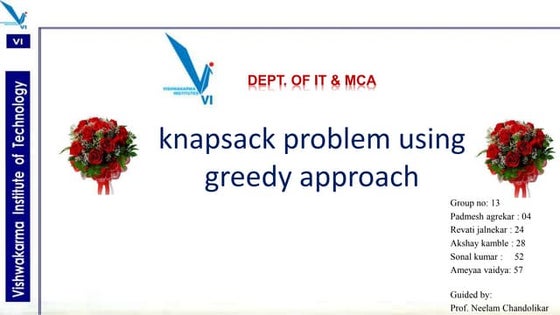



Knapsack problem using greedy approachpadmeshagrekar
╠²
In shared PPT we have discussed Knapsack problem using greedy approach and its two types i.e Fractional and 0-1Job sequencing with Deadlines



Job sequencing with DeadlinesYashiUpadhyay3
╠²
The document describes the job sequencing problem with deadlines and presents a greedy algorithm to solve it. The problem involves scheduling a set of jobs on a single processor to maximize total profit where each job has a deadline and profit. The greedy algorithm sorts jobs by decreasing profit and schedules each job as late as possible while meeting its deadline. This approach always finds the optimal solution that maximizes total profit. Pseudocode and a C++ program implementing the algorithm are also provided.Job sequencing with deadline



Job sequencing with deadlineArafat Hossan
╠²
This document discusses the job sequencing problem, where the goal is to schedule jobs to be completed by their deadlines to maximize total profit. It provides an example problem with 4 jobs, their profits, deadlines, and the optimal solution of scheduling jobs J1 and J2 to earn a total profit of 140.Introduction to Dynamic Programming, Principle of Optimality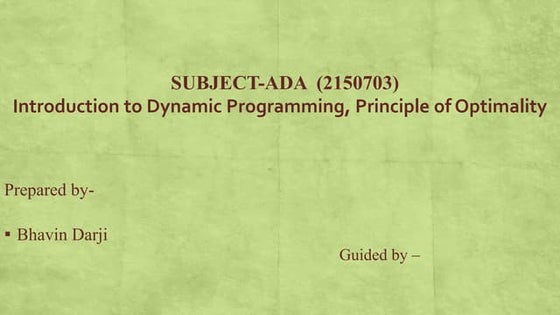



Introduction to Dynamic Programming, Principle of OptimalityBhavin Darji
╠²
Introduction
Dynamic Programming
How Dynamic Programming reduces computation
Steps in Dynamic Programming
Dynamic Programming Properties
Principle of Optimality
Problem solving using Dynamic Programming
Knapsack Problem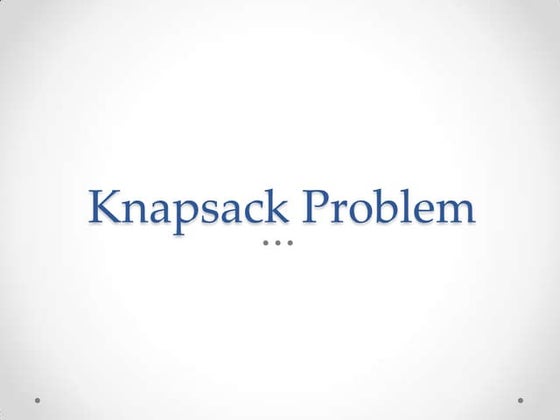



Knapsack ProblemJenny Galino
╠²
The document discusses the knapsack problem, which involves selecting a subset of items that fit within a knapsack of limited capacity to maximize the total value. There are two versions - the 0-1 knapsack problem where items can only be selected entirely or not at all, and the fractional knapsack problem where items can be partially selected. Solutions include brute force, greedy algorithms, and dynamic programming. Dynamic programming builds up the optimal solution by considering all sub-problems.Ubiquitous Computing



Ubiquitous ComputingKamran Ashraf
╠²
Ubiquitous computing refers to technology that is integrated into everyday life to the extent that it is indistinguishable from it. The vision is for computing services to be available anytime and anywhere through devices that are increasingly more powerful, smaller, and cheaper. Ubiquitous computing is changing daily activities by allowing people to communicate and interact with hundreds of computing devices in new ways. However, it also presents challenges in systems design, security and privacy, and how teaching and learning can take advantage of ubiquitous access to resources and tools.Longest Common Subsequence



Longest Common SubsequenceSwati Swati
╠²
The document discusses the longest common subsequence (LCS) problem and how to solve it using dynamic programming. It begins by defining LCS as the longest sequence of characters that appear left-to-right in two given strings. It then describes solving LCS using a brute force method with exponential time complexity and using dynamic programming with polynomial time complexity. Finally, it provides an example of finding the LCS of two strings and discusses applications and references.More Related Content
What's hot (20)
Algorithms Lecture 1: Introduction to Algorithms



Algorithms Lecture 1: Introduction to AlgorithmsMohamed Loey
╠²
We will discuss the following: Algorithms, Time Complexity & Space Complexity, Algorithm vs Pseudo code, Some Algorithm Types, Programming Languages, Python, Anaconda.Dynamic programming



Dynamic programmingY─▒ld─▒r─▒m Tam
╠²
A. Plannig
The document mentions that in dynamic programming, "Programming" refers to "planning", not computer programming.0/1 knapsack



0/1 knapsackAmin Omi
╠²
The document discusses the 0-1 knapsack problem and how it can be solved using dynamic programming. It first defines the 0-1 knapsack problem and provides an example. It then explains how a brute force solution would work in exponential time. Next, it describes how to define the problem as subproblems and derive a recursive formula to solve the subproblems in a bottom-up manner using dynamic programming. This builds up the solutions in a table and solves the problem in polynomial time. Finally, it walks through an example applying the dynamic programming algorithm to a sample problem instance.Bruteforce algorithm



Bruteforce algorithmRezwan Siam
╠²
This powerpoint slide is for educational purposes only.!
We have given our best to educate people about the basic brute-force algorithm. Best of luck.Fractional Knapsack Problem



Fractional Knapsack Problemharsh kothari
╠²
This document discusses the greedy algorithm approach and the knapsack problem. It defines greedy algorithms as choosing locally optimal solutions at each step in hopes of reaching a global optimum. The knapsack problem is described as packing items into a knapsack to maximize total value without exceeding weight capacity. An optimal knapsack algorithm is presented that sorts by value-to-weight ratio and fills highest ratios first. An example applies this to maximize profit of 440 by selecting full quantities of items B and A, and half of item C for a knapsack with capacity of 60.Strassen's matrix multiplication



Strassen's matrix multiplicationMegha V
╠²
The document discusses Strassen's algorithm for matrix multiplication. It begins by explaining traditional matrix multiplication that has a time complexity of O(n3). It then explains how the divide and conquer strategy can be applied by dividing the matrices into smaller square sub-matrices. Strassen improved upon this by reducing the number of multiplications from 8 to 7 terms, obtaining a time complexity of O(n2.81). His key insight was applying different equations on the sub-matrix multiplication formulas to minimize operations.Quick sort Algorithm Discussion And Analysis



Quick sort Algorithm Discussion And AnalysisSNJ Chaudhary
╠²
Quicksort is a divide-and-conquer algorithm that works by partitioning an array around a pivot element and recursively sorting the subarrays. In the average case, it has an efficiency of ╬ś(n log n) time as the partitioning typically divides the array into balanced subproblems. However, in the worst case of an already sorted array, it can be ╬ś(n^2) time due to highly unbalanced partitioning. Randomizing the choice of pivot helps avoid worst-case scenarios and achieve average-case efficiency in practice, making quicksort very efficient and commonly used.Hashing Technique In Data Structures



Hashing Technique In Data StructuresSHAKOOR AB
╠²
This document discusses different searching methods like sequential, binary, and hashing. It defines searching as finding an element within a list. Sequential search searches lists sequentially until the element is found or the end is reached, with efficiency of O(n) in worst case. Binary search works on sorted arrays by eliminating half of remaining elements at each step, with efficiency of O(log n). Hashing maps keys to table positions using a hash function, allowing searches, inserts and deletes in O(1) time on average. Good hash functions uniformly distribute keys and generate different hashes for similar keys.Greedy algorithms



Greedy algorithmssandeep54552
╠²
Greedy algorithms work by making locally optimal choices at each step to arrive at a global optimal solution. They require that the problem exhibits the greedy choice property and optimal substructure. Examples that can be solved with greedy algorithms include fractional knapsack problem, minimum spanning tree, and activity selection. The fractional knapsack problem is solved greedily by sorting items by value/weight ratio and filling the knapsack completely. The 0/1 knapsack problem differs in that items are indivisible.Matrix chain multiplication



Matrix chain multiplicationRespa Peter
╠²
Dynamic Programming is a technique for algorithm design.
It is a tabular method in which it uses divide-and-conquer to solve problems.Assignment problem branch and bound.pptx



Assignment problem branch and bound.pptxKrishnaVardhan50
╠²
1. Branch and bound is an algorithm that uses a state space tree to solve optimization problems like the knapsack problem and traveling salesman problem. It works by recursively dividing the solution space and minimizing costs at each step.
2. The document then provides an example of using branch and bound to solve a job assignment problem with 4 jobs and 4 people. It calculates lower bounds at each step of the algorithm and prunes branches that cannot lead to an optimal solution.
3. After exploring the solution space, the algorithm arrives at the optimal assignment of Person A to Job 2, Person B to Job 1, Person C to Job 3, and Person D to Job 4, with a minimum total cost of 21.Stressen's matrix multiplication



Stressen's matrix multiplicationKumar
╠²
Strassen's algorithm improves on the basic matrix multiplication algorithm which runs in O(N3) time. It achieves this by dividing the matrices into sub-matrices and performing 7 multiplications and 18 additions on the sub-matrices, rather than the 8 multiplications of the basic algorithm. This results in a runtime of O(N2.81) using divide and conquer, providing an asymptotic improvement over the basic O(N3) algorithm.Daa:Dynamic Programing



Daa:Dynamic Programingrupali_2bonde
╠²
Dynamic programming is used to solve optimization problems by breaking them down into subproblems. It solves each subproblem only once, storing the results in a table to lookup when the subproblem recurs. This avoids recomputing solutions and reduces computation. The key is determining the optimal substructure of problems. It involves characterizing optimal solutions recursively, computing values in a bottom-up table, and tracing back the optimal solution. An example is the 0/1 knapsack problem to maximize profit fitting items in a knapsack of limited capacity.daa-unit-3-greedy method



daa-unit-3-greedy methodhodcsencet
╠²
The document discusses the greedy method algorithmic approach. It provides an overview of greedy algorithms including that they make locally optimal choices at each step to find a global optimal solution. The document also provides examples of problems that can be solved using greedy methods like job sequencing, the knapsack problem, finding minimum spanning trees, and single source shortest paths. It summarizes control flow and applications of greedy algorithms.Branch and bound



Branch and boundNv Thejaswini
╠²
Branch and Bound is a state space search algorithm that involves generating all children of a node before exploring any children. It uses lower bounds to prune parts of the search tree that cannot produce better solutions than what has already been found. The algorithm is demonstrated on problems like the 8-puzzle and Travelling Salesman Problem. For TSP, it works by reducing the cost matrix at each node to calculate lower bounds, and exploring the child with the lowest estimated total cost.Knapsack problem using greedy approach



Knapsack problem using greedy approachpadmeshagrekar
╠²
In shared PPT we have discussed Knapsack problem using greedy approach and its two types i.e Fractional and 0-1Job sequencing with Deadlines



Job sequencing with DeadlinesYashiUpadhyay3
╠²
The document describes the job sequencing problem with deadlines and presents a greedy algorithm to solve it. The problem involves scheduling a set of jobs on a single processor to maximize total profit where each job has a deadline and profit. The greedy algorithm sorts jobs by decreasing profit and schedules each job as late as possible while meeting its deadline. This approach always finds the optimal solution that maximizes total profit. Pseudocode and a C++ program implementing the algorithm are also provided.Job sequencing with deadline



Job sequencing with deadlineArafat Hossan
╠²
This document discusses the job sequencing problem, where the goal is to schedule jobs to be completed by their deadlines to maximize total profit. It provides an example problem with 4 jobs, their profits, deadlines, and the optimal solution of scheduling jobs J1 and J2 to earn a total profit of 140.Introduction to Dynamic Programming, Principle of Optimality



Introduction to Dynamic Programming, Principle of OptimalityBhavin Darji
╠²
Introduction
Dynamic Programming
How Dynamic Programming reduces computation
Steps in Dynamic Programming
Dynamic Programming Properties
Principle of Optimality
Problem solving using Dynamic Programming
Knapsack Problem



Knapsack ProblemJenny Galino
╠²
The document discusses the knapsack problem, which involves selecting a subset of items that fit within a knapsack of limited capacity to maximize the total value. There are two versions - the 0-1 knapsack problem where items can only be selected entirely or not at all, and the fractional knapsack problem where items can be partially selected. Solutions include brute force, greedy algorithms, and dynamic programming. Dynamic programming builds up the optimal solution by considering all sub-problems.Viewers also liked (9)
Ubiquitous Computing



Ubiquitous ComputingKamran Ashraf
╠²
Ubiquitous computing refers to technology that is integrated into everyday life to the extent that it is indistinguishable from it. The vision is for computing services to be available anytime and anywhere through devices that are increasingly more powerful, smaller, and cheaper. Ubiquitous computing is changing daily activities by allowing people to communicate and interact with hundreds of computing devices in new ways. However, it also presents challenges in systems design, security and privacy, and how teaching and learning can take advantage of ubiquitous access to resources and tools.Longest Common Subsequence



Longest Common SubsequenceSwati Swati
╠²
The document discusses the longest common subsequence (LCS) problem and how to solve it using dynamic programming. It begins by defining LCS as the longest sequence of characters that appear left-to-right in two given strings. It then describes solving LCS using a brute force method with exponential time complexity and using dynamic programming with polynomial time complexity. Finally, it provides an example of finding the LCS of two strings and discusses applications and references.Longest common subsequence lcs



Longest common subsequence lcsShahariar Rabby
╠²
Longest common sub sequence, The Longest Common Subsequence Problem. Work Examples. Traceback Approach. no code.
Dynamic Programming - Part II



Dynamic Programming - Part IIAmrinder Arora
╠²
Dynamic Programming design technique is one of the fundamental algorithm design techniques, and possibly one of the ones that are hardest to master for those who did not study it formally. In these slides (which are continuation of part 1 slides), we cover two problems: maximum value contiguous subarray, and maximum increasing subsequence.Dynamic Programming - Part 1



Dynamic Programming - Part 1Amrinder Arora
╠²
This document discusses dynamic programming techniques. It covers matrix chain multiplication and all pairs shortest paths problems. Dynamic programming involves breaking down problems into overlapping subproblems and storing the results of already solved subproblems to avoid recomputing them. It has four main steps - defining a mathematical notation for subproblems, proving optimal substructure, deriving a recurrence relation, and developing an algorithm using the relation.Lecture 8 dynamic programming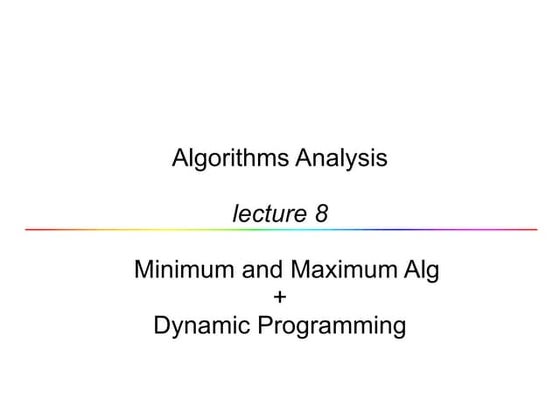



Lecture 8 dynamic programmingOye Tu
╠²
This document discusses algorithms for finding minimum and maximum elements in an array, including simultaneous minimum and maximum algorithms. It introduces dynamic programming as a technique for improving inefficient divide-and-conquer algorithms by storing results of subproblems to avoid recomputing them. Examples of dynamic programming include calculating the Fibonacci sequence and solving an assembly line scheduling problem to minimize total time.Dynamic Programming



Dynamic ProgrammingSahil Kumar
╠²
it contains the detail information about Dynamic programming, Knapsack problem, Forward / backward knapsack, Optimal Binary Search Tree (OBST), Traveling sales person problem(TSP) using dynamic programming The Top Skills That Can Get You Hired in 2017



The Top Skills That Can Get You Hired in 2017LinkedIn
╠²
We analyzed all the recruiting activity on LinkedIn this year and identified the Top Skills employers seek. Starting Oct 24, learn these skills and much more for free during the Week of Learning.
#AlwaysBeLearning https://learning.linkedin.com/week-of-learningState of the Word 2011



State of the Word 2011photomatt
╠²
The document discusses the benefits of exercise for both physical and mental health. It notes that regular exercise can reduce the risk of diseases like heart disease and diabetes, improve mood, and reduce feelings of stress and anxiety. The document recommends that adults get at least 150 minutes of moderate exercise or 75 minutes of vigorous exercise per week to gain these benefits.Similar to The Maximum Subarray Problem (20)
Brute Force and Divide & Conquer Technique



Brute Force and Divide & Conquer Techniquessusered62011
╠²
Brute Force and Divide & Conquer techniquesCalculus Assignment Help



Calculus Assignment HelpMath Homework Solver
╠²
I am Anne L. I am a Calculus Assignment Solver at mathhomeworksolver.com. I hold a Master's in Mathematics, from the University of California, USA. I have been helping students with their assignments for the past 5 years. I solved assignments related to Calculus.
Visit mathhomeworksolver.com or email support@mathhomeworksolver.com. You can also call on +1 678 648 4277 for any assistance with Calculus Assignments.Daa chapter 2



Daa chapter 2B.Kirron Reddi
╠²
The document discusses the divide and conquer algorithm design technique. It begins by defining divide and conquer as breaking a problem down into smaller subproblems, solving the subproblems, and then combining the solutions to solve the original problem. It then provides examples of applying divide and conquer to problems like matrix multiplication and finding the maximum subarray. The document also discusses analyzing divide and conquer recurrences using methods like recursion trees and the master theorem.Calculus Assignment Help



Calculus Assignment HelpMaths Assignment Help
╠²
I am Katie P. I am a Calculus Assignment Expert at mathsassignmenthelp.com. I hold a Master's in Mathematics from, Concordia University. I have been helping students with their assignments for the past 14 years. I solve assignments related to Calculus.
Visit mathsassignmenthelp.com or email info@mathsassignmenthelp.com.
You can also call on +1 678 648 4277 for any assistance with Calculus Assignment. Brute force-algorithm



Brute force-algorithm9854098540
╠²
The brute force algorithm finds the maximum subarray of a given array by calculating the sum of all possible contiguous subarrays. It has a time complexity of O(n^2) as it calculates the sum in two nested loops from index 1 to n. While simple to implement, the brute force approach is only efficient for small problem sizes due to its quadratic time complexity. More optimized algorithms are needed for large arrays.Sienna 13 limitations



Sienna 13 limitationschidabdu
╠²
This document discusses limitations of algorithms and lower bounds on algorithm efficiency. It begins by defining lower bounds as estimates of the minimum work needed to solve a problem. It then provides examples of problems and their known lower bounds, including sorting arrays and multiplying matrices. The document discusses methods for establishing lower bounds, such as trivial counting arguments, information theory using decision trees, adversary arguments, and problem reduction. It provides examples for each method.Maximum Subarray Sum in Python



Maximum Subarray Sum in PythonKal Bartal
╠²
This document discusses finding the maximum subarray sum in a given array. It begins by defining the problem of finding the contiguous subarray with the largest sum. It then explains solving it using a dynamic programming approach. The solution loops through the array, tracking the maximum sum of subarrays from the start of the array at each index. This allows finding the maximum sum subarray in O(n) time and space complexity. In the end, the document emphasizes understanding the problem fully before coding and how dynamic programming enables efficient solutions.Calculus Homework Help



Calculus Homework HelpMath Homework Solver
╠²
I am Manuela B. I am a Calculus Homework Solver at mathhomeworksolver.com. I hold a Master's in Mathematics, from the University of Warwick. I have been helping students with their homework for the past 7 years. I solve homework related to Calculus.
Visit mathhomeworksolver.com or email support@mathhomeworksolver.com. You can also call on +1 678 648 4277 for any assistance with Calculus Homework. Computer Science Exam Help 



Computer Science Exam Help Programming Exam Help
╠²
I am Marianna P. I am a Computer Science Exam Expert at programmingexamhelp.com. I hold a Bachelor of Information Technology from, California Institute of Technology, United States. I have been helping students with their exams for the past 12 years. You can hire me to take your exam in Computer Science.
Visit programmingexamhelp.com or email support@programmingexamhelp.com. You can also call on +1 678 648 4277 for any assistance with the Computer Science Exam.
Statistical computing with r estatistica - maria l. rizzo



Statistical computing with r estatistica - maria l. rizzoAndr├® Oliveira Souza
╠²
The simplex method is an optimization technique used to solve linear programming problems with linear objective functions and constraints. It works by evaluating the objective function at the vertices of the feasible region (which is a simplex) and moving from vertex to vertex in the direction of improving the objective. The simplex method is implemented in the simplex function in R's boot package, which can maximize or minimize a linear function subject to linear equality and inequality constraints. The document provides an example problem solved using the simplex method via this function.Algorithms Exam Help



Algorithms Exam HelpProgramming Exam Help
╠²
I am Joanna R. I am an Algorithm Exam Expert at programmingexamhelp.com. I hold a Bachelor of Information Technology from, the California Institute of Technology, United States. I have been helping students with their exams for the past 9 years. You can hire me to take your exam in Algorithm.
Visit programmingexamhelp.com or email support@programmingexamhelp.com. You can also call on +1 678 648 4277 for any assistance with the Algorithm Exam.Daa chapter6



Daa chapter6B.Kirron Reddi
╠²
There are three main limitations of algorithms:
1) Some problems cannot be solved by any algorithm.
2) Some problems can be solved algorithmically but not in polynomial time.
3) Some problems can be solved in polynomial time but existing algorithms are not efficient.
Lower bounds help establish the minimum efficiency of algorithms. There are four main methods to determine lower bounds: trivial counting arguments, information theory, adversary arguments, and problem reduction. Decision trees can also help analyze comparison-based algorithms and establish lower bounds.Unit-3 greedy method, Prim's algorithm, Kruskal's algorithm.pdf



Unit-3 greedy method, Prim's algorithm, Kruskal's algorithm.pdfyashodamb
╠²
The Greedy Method: Introduction, Huffman Trees and codes, Minimum
Coin Change problem, Knapsack problem, Job sequencing with deadlines,
Minimum Cost Spanning Trees, Single Source Shortest paths. Solution 3.



Solution 3.sansaristic
╠²
The document contains exercises, hints, and solutions for analyzing algorithms from a textbook. It includes problems related to brute force algorithms, sorting algorithms like selection sort and bubble sort, and evaluating polynomials. The solutions analyze the time complexity of different algorithms, such as proving that a brute force polynomial evaluation algorithm is O(n^2) while a modified version is linear time. It also discusses whether sorting algorithms like selection sort and bubble sort preserve the original order of equal elements (i.e. whether they are stable).Divide and Conquer / Greedy Techniques



Divide and Conquer / Greedy TechniquesNirmalavenkatachalam
╠²
Divide and conquer is an algorithm design paradigm where a problem is broken into smaller subproblems, those subproblems are solved independently, and then their results are combined to solve the original problem. Some examples of algorithms that use this approach are merge sort, quicksort, and matrix multiplication algorithms like Strassen's algorithm. The greedy method works in stages, making locally optimal choices at each step in the hope of finding a global optimum. It is used for problems like job sequencing with deadlines and the knapsack problem. Minimum cost spanning trees find subgraphs of connected graphs that include all vertices using a minimum number of edges.Programming Exam Help 



Programming Exam Help Programming Exam Help
╠²
I am Joanna R. I am a Programming Exam Expert at programmingexamhelp.com. I hold a Bachelor of Information Technology from, California Institute of Technology, United States. I have been helping students with their exams for the past 11 years. You can hire me to take your exam in Programming.
Visit programmingexamhelp.com or email support@programmingexamhelp.com. You can also call on +1 678 648 4277 for any assistance with the Programming Exam.Algorithm Homework Help



Algorithm Homework HelpProgramming Homework Help
╠²
This document provides information about homework help services and programming homework help. It lists contact details including a phone number and email address to get help with homework queries. It also provides a website URL for programming homework help. The document then presents sample programming homework problems and solutions.Learn Dynamic Programming Roadmap at Tutort Academy



Learn Dynamic Programming Roadmap at Tutort AcademyTutort Academy
╠²
Dynamic Programming is mainly an optimization over plain recursion. Wherever we see a recursive solution that has repeated calls for the same inputs, we can optimize it using Dynamic Programming. Undecidable Problems and Approximation Algorithms



Undecidable Problems and Approximation AlgorithmsMuthu Vinayagam
╠²
The document discusses algorithm limitations and approximation algorithms. It begins by explaining that some problems have no algorithms or cannot be solved in polynomial time. It then discusses different algorithm bounds and how to derive lower bounds through techniques like decision trees. The document also covers NP-complete problems, approximation algorithms for problems like traveling salesman, and techniques like branch and bound. It provides examples of approximation algorithms that provide near-optimal solutions when an optimal solution is impossible or inefficient to find.test pre



test prefarazch
╠²
The document discusses greedy algorithms and their properties. It describes how greedy algorithms work by making locally optimal choices at each step in the hope of reaching a globally optimal solution. Two examples are given: the activity selection problem and finding minimum spanning trees. Prim's algorithm for finding minimum spanning trees is described in detail, showing how it works by always selecting the lightest edge between the growing tree and remaining vertices.The Maximum Subarray Problem
- 1. The Maximum Subarray Problem Defining problem , its brute force solution, divide and conquer solution Presented by: Kamran Ashraf
- 2. Formal Problem Definition ŌĆó Given a sequence of numbers <a1,a2,ŌĆ”..an> we work to find a subsequence of A that is contiguous and whose values have the maximum sum. ŌĆó Maximum Subarray problem is only challenging when having both positive and negative numbers.
- 3. ĘĪ│µ▓╣│Š▒Ķ▒¶▒ŌĆ” Here, the subarray A[8ŌĆ”11] is the Maximum Subarray, with sum 43, has the greatest sum of any contiguous subarray of array A.
- 4. Brute Force Solution To solve the Maximum Subarray Problem we can use brute force solution however in brute force we will have to compare all possible continuous subarray which will increase running time. Brute force will result in č▓(n2), and the best we can hope for is to evaluate each pair in constant time which will result in ßĮ©(n2). Divide and Conquer is a more efficient method for solving large number of problems resulting in č▓(nlogn).
- 5. Divide and Conquer Solution ŌĆó First we Divide the array A [low ŌĆ” high] into two subarrays A [low ŌĆ” mid] (left) and A [mid +1 ŌĆ” high] (right). ŌĆó We recursively find the maximum subarray of A [low ŌĆ” mid] (left), and the maximum of A [mid +1 ŌĆ” high] (right). ŌĆó We also find maximum crossing subarray that crosses the midpoint. ŌĆó Finally we take a subarray with the largest sum out of three.
- 7. Time Analysis ŌĆó Find-Max-Cross-Subarray takes: č▓ (n) time ŌĆó Two recursive calls on input size n/2 takes: 2T(n/2) time ŌĆó Hence: T(n) = 2T(n/2) + č▓ (n) T(n) = č▓ (n log n)
- 8. Pseudo Code Max-subarray(A, Left, Right) if (Right == Left) return (left, right, A[left]) else mid= [(left+right)/2] L1=Find-Maximum-Subarray(A,left,mid) R1=Find-Maximum-Subarray(A,mid+1,right) M1=Find-Max-Crossing-Subarray(A,left,mid,right) If sum(L1) > sum(R1) and sum(L1) > sum(M1) Return L1 elseif sum(R1) > sum(L1) and sum(R1) > sum(M1) Return R1 Else return M1
